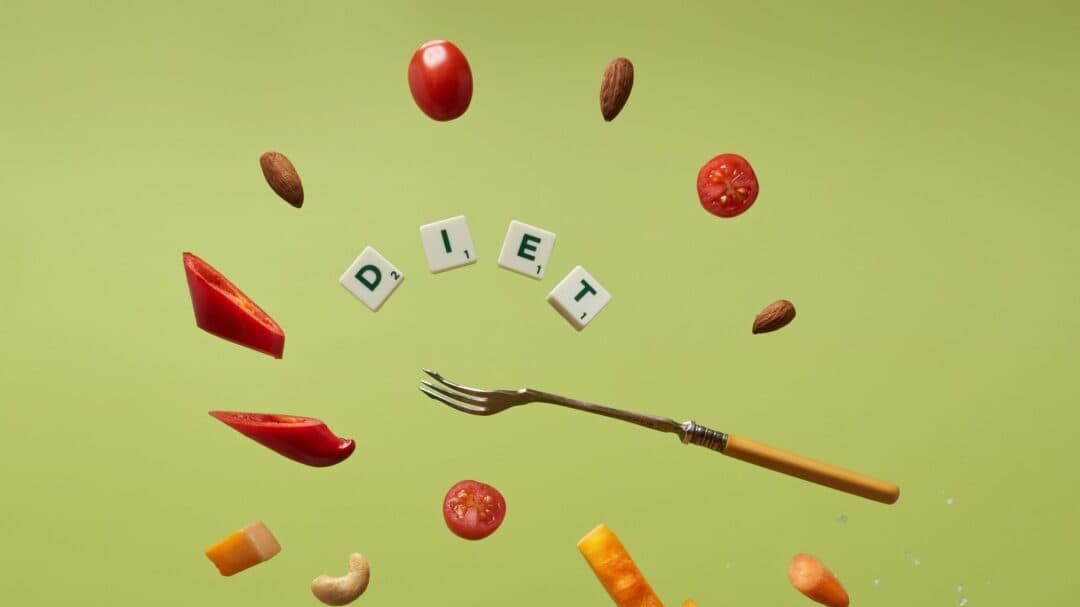Jump to: A balanced diet: It’s not about perfection | Step 1: Balance your plate | Step 2: Personalise energy intake for your lifestyle | Step 3: Eat mindfully | Take home message
A balanced diet: It’s not about perfection
A truly balanced healthy diet doesn’t restrict you from entire food groups or place rigid rules and restrictions on how you should or shouldn’t eat.
It incorporates all foods as part of your lifestyle, whether the more health-promoting whole foods or the occasional sweet dessert.
This may sound surprising, but there’s a misconception that you must eat ‘clean’ and only eat healthy foods like fruits, vegetables, and oily fish.
This couldn’t be further from the truth. Yes, consuming a diet based on whole foods will promote good health, but this doesn’t mean you can only eat foods considered ‘healthy’.
Developing a positive relationship with food, one where all foods can be considered part of a balanced diet and lifestyle, is where we want to get to.
From Second Nature’s perspective, a balanced diet encourages the consumption of:
- High-quality protein sources: Fish, meat, eggs, tofu, tempeh, yoghurt, cheese, and seafood.
- Fat from whole foods: Meat, fish, eggs, dairy products (rich in calcium), nuts, seeds, avocado, and extra virgin olive oil.
- High-fibre carbohydrates: Whole grains like quinoa and brown rice, sweet potato, white potatoes, pumpkin, legumes like lentils, chickpeas, beans, and butternut squash.
- Fruits and vegetables: Take your pick!

We also encourage limiting the following foods, but they can still be included from time to time:
- Refined carbohydrates: White rice, breakfast cereals, supermarket bread.
- Added sugar: Fruit juice or added into drinks or meals.
- Refined oils: Sunflower and vegetable oils.
- Ultra-processed foods: Pastries, low-calorie/low-fat products, microwave meals, fast food, breakfast cereals, frozen pizzas, and frozen desserts.
- Trans fats.
Alongside the food, we encourage some healthy habits to support a balanced diet:
- Eat three meals a day: This will help keep your hunger pangs at bay to help you achieve a healthy weight.
- Eat until you’re comfortably full: You’ll know when you’ve had enough by tuning into your physical hunger cues to avoid weight gain.
- Enjoy healthy snacks when needed: Sometimes, you’ll have more extended periods between meals. A healthy snack, such as an apple and peanut butter, can tie you over until your next main meal.
- Don’t count calories or track macros: We don’t believe you need to count and track what you’re eating to maintain a healthy balance. It’s not just tedious, but good evidence suggests other approaches are as effective at supporting weight management and health.
- Stay hydrated: 1-2l of water a day will keep your body functioning well and the hunger pangs at bay.
- Eat mindfully: By paying attention to your food and being free from distraction, you’re more likely to eat until you’re comfortably full.
- Home-baking: While we don’t actively encourage the excess consumption of sweet foods, we feel that by making them yourself, you’re more likely to develop a healthy relationship with those ingredients and enjoy it mindfully.
The world of diet and nutrition is a complicated space to navigate. With so many different diets, knowing which one to choose is challenging. Should you go on a keto diet? A Mediterranean diet? Vegan? Why not try a carnivore for a month?
Diets often fail due to adherence. The truth is people find it too challenging to stick to rigid rules and restrictions that often come as part of the package of the diet you’re on at the time.
Then when you veer outside of the rules of the diet, you feel like you’ve failed, you feel guilty, you feel it’s your fault, and you ‘fall off the wagon’.
However, you haven’t failed at all. The diet has failed you – and any future diet you try, even if you find short-term success, will probably fail in the long run.
At Second Nature, we want to focus on what you’re adding to your life rather than what you’re taking away.
You’re including a wide variety of foods in your diet, adding more energy to your body and mind. You’re more productive, happier, and more capable of dealing with life’s many ups and downs.
Second Nature isn’t a diet. It’s a way of living, and if you’d like to join over 150,000 others who are now enjoying numerous health benefits, click here to take our health quiz.
Otherwise, keep reading as we look at three habits you can start today to help you build a balanced diet to help you achieve your health goals, whether that’s weight loss or simply feeling healthier.
Step 1: Balance your plate
The first step to developing a balanced diet is learning how to build your meals to ensure they contain everything your body needs.
We recommend the majority of your meals contain around:
- 25% high-fibre carbohydrates
- 25% protein
- 50% non-starchy vegetables (or one to two portions of fruit)
- At least one serving of fat
You can see an example of how this looks with our creamy chicken and mushroom stroganoff with steamed kale and boiled potatoes with a dash of melted butter.
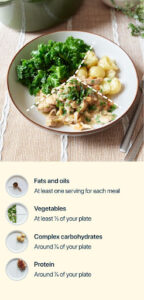
Plating up
When you’re cooking for multiple people or your whole family, it can be highly tedious trying to measure out the exact servings as you’re cooking. We recommend using our hand portion guide when you’re serving your meals.
This way, you’re saving time when you’re cooking and ensuring that you’re cooking enough for everyone, and you can then serve up the right amount for your plate. Any leftovers can be put into the fridge or freezer to save you cooking time across the week.
Here’s how it might look from start to finish.
Start by serving up one fist-sized portion of carbohydrates: For this meal, it’s hand-cut chips.
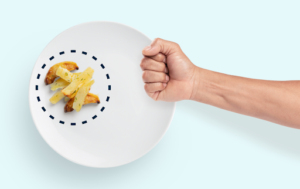
Then serve one palm-sized portion of protein: For this meal, it’s a griddled steak.

Followed by two palm-sized portions of vegetables: For this meal, it’s a mixed-vegetable salad.
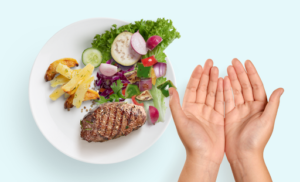
Finally, you can add a minimum of one thumb-sized portion of fat (add one or two more if you feel you need to): For this meal, it’s walnuts, and you could add some extra virgin olive oil as a dressing.
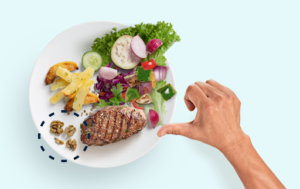
A day’s balanced intake
So far, we’ve covered what the overall balance of your meals should look like and how to serve up your meals. Now, let’s look at what a whole day might look like.
Breakfast
Some breakfasts might be sweet and contain fruit, while others might be savoury and contain roasted or sauteed vegetables. Either way, the same guidelines apply.
You might find that some meals are more carb-heavy than others (the porridge) and others contain more fat (the omelette), which is perfectly fine.
You don’t need to feel like every meal is the perfect balance of carbs and fat, it can change meal-to-meal, and we encourage you to experiment.
This flexibility might relieve some of the stress of a meal, knowing they don’t always have to contain a portion of carbs, and your fat intake might be higher, for example.
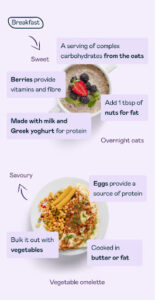
Lunch
The following meals are both using chicken as their source of protein. However, this can easily be replaced by tofu or tempeh if you’re on a plant-based diet (vegan or vegetarian).
We’d recommend using extra virgin olive oil as your source of fat in the bean stew and cold-pressed rapeseed or cold-pressed sesame seed oil for the nutty Asian salad.
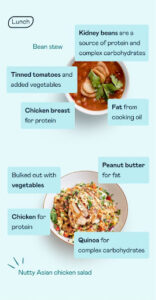
Dinner
These meals again use chicken as their source of protein, but tofu or tempeh would be a great substitute. Paneer or halloumi would also work well in both recipes for vegetarians who consume dairy foods.
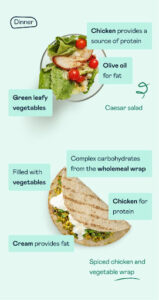
Based on science
Our approach is based on the latest nutrition and health science research to manage obesity, type 2 diabetes, and lower your risk of heart disease (our programme has also been shown to be effective at treating high blood pressure).
Our in-house registered dietitians and nutritionists have spent the past five years developing and improving our dietary guidelines to be as health-promoting and flexible as possible.
Don’t just take our word for it; the NHS has commissioned us to deliver programmes for people living with type 2 diabetes and obesity since 2017.
For a quick summary of why we’ve chosen this approach to food and nutrition, watch this short video:
If you’d like to read through some of the science yourself, here’s a list of critical references to support our approach to nutrition:
- Systematic review and meta-analysis of different dietary approaches to the management of type 2 diabetes
- Glycemic Index, Glycemic Load, Carbohydrates, and Type 2 Diabetes: Systematic review and dose–response meta-analysis of prospective studies
- Efficacy and safety of low and very low carbohydrate diets for type 2 diabetes remission: systematic review and meta-analysis of published and unpublished randomized trial data
- Weight Loss with a Low-Carbohydrate, Mediterranean, or Low-Fat Diet
Key points:
- Most of your meals should contain around 25% carbohydrates, 25% protein, 50% vegetables (or one to two servings of fruit), and a minimum of one serving of fat.
- You can use our hand portion guide to serve your balanced meals. Any leftovers can go into the fridge or freezer to save cooking time.
- Not all your meals need to be perfect. Some might be more carb-heavy, others with higher fat levels – this is normal and gives you more flexibility.
- Our guidelines are based on the latest nutrition science research and have been developed and improved by our registered dietitians and nutritionists.
Step 2: Personalise energy intake for your lifestyle
Second Nature’s nutrition guidelines have been specifically designed for people living with obesity and type 2 diabetes to help people lose weight and manage their blood sugar levels.
However, they can be translated to anyone who leads a healthy lifestyle. But it would help if you increased your energy intake to support your physical activity levels.
Our primary energy sources
Our body’s two primary energy sources are fat and carbohydrates. Consider fat as your ‘slow-burning’ fuel and carbohydrate as your ‘fast-burning’ fuel.
Carbohydrates are also your brain’s key energy source in a mixed diet. While other organs, such as your heart, tend to burn more fat at rest and lower-intensity exercise.
Providing our body with both forms of energy means it can switch between using the two when needed. Additionally, different organs (such as the brain and the heart) can use what fuel they’re more naturally designed to burn.
Tailoring it to your activity levels
Let’s say you do higher-intensity exercise three times a week. On the other days, you either rest or do lower-intensity exercises such as walking or yoga. You can still use the same hand portion guide above, but you can flex it to suit the demands of that particular day.
For example, on Monday, you might do a 90-minute HIIT (high-intensity interval training) class at your local gym at lunchtime, so you can use two fistfuls of carbohydrates in your lunch and dinner time meal.
Then on Tuesday, you have a thirty-minute walk at lunchtime with your dog. So, perhaps you don’t need as many carbohydrates in your meals, but you could enjoy more fat to provide you with enough slow-burning energy.
We’d ask you to experiment with what works for you. No day will be perfect, and no day will be the same. The portions recommended in Step 1 are a great foundation, but you might need to increase carbs and fat up or down to suit your preferences, goals, and lifestyle.
Important: Protein and fibre intake should remain constant. While carbs and fat might shift daily, protein and fibre intake should remain the same to support essential functions and gut health.
Eat until you’re comfortably full
You might be thinking, “how do I know when I’m eating enough or too much?”. This is when we’d encourage you to learn to tune into your physical hunger and fullness signals.
The next time you eat a meal, use the Second Nature hunger scale to know when to stop eating. Generally, we want to get to around five to seven; this will be when you’re comfortably full.
If you’re below five, you need to continue or start eating. Above eight, you know you’ve had too much, and you can adapt your portion size for next time.
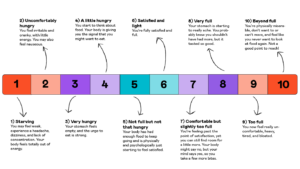
Key points:
- Second Nature’s nutrition guidelines are designed for people living with obesity or type 2 diabetes.
- Anyone can use them as a foundation to eat a balanced diet; they might need to include more energy to suit their lifestyle.
- Carbs and fat are our primary energy sources, and their intake can vary day-to-day depending on how much you exercise, social events, or what you choose to eat that day.
- Using the hunger scale can help you learn to listen to your body’s physical hunger cues.
Step 3: Eat mindfully
Mindful eating is practising paying attention to the food you’re eating on purpose without judgement. You may have seen mindful eating trending on social media; fortunately, it’s not just a fad.
Research has suggested that mindful eating can aid weight loss for people living with obesity, curb carb and sugar cravings, and support healthy eating habits.
It trains you to tune into your internal hunger signals (satiety), build a positive relationship with food to support your mental health, and savour your meals to feel satisfied.
We’ve got a complete guide on how to eat mindfully here, but as a summary, you can learn to eat mindfully in three simple steps:
- Eat without distraction: Enjoy your eating experience. eat at a table at mealtimes, and switch off your television, laptop, or smartphone.
- Take your time: Chew your food thoroughly, tune into the physical sensations you experience, and sip water between bites. Take 20 seconds per mouthful and 20 minutes for every meal.
- Eat until you’re comfortably full: Use the Second Nature hunger scale above.
Key points:
- Mindful eating is practising paying attention to your food on purpose and without judgement.
- You can learn to eat mindfully by eating without distraction, taking time, and eating until you’re comfortably full.
Take home message
With so many diets and weight loss fads out there, it’s no surprise that many people are confused about what a balanced diet looks like. We can often overcomplicate it by adding too many rules, guidelines, and restrictions.
The exact make-up of your diet will be different to others. What we’ve tried to do at Second Nature is provide a framework in which people can learn to nourish themselves for the long term.
Hopefully, you’ll feel more confident about what a balanced diet looks like and put it to practice.

